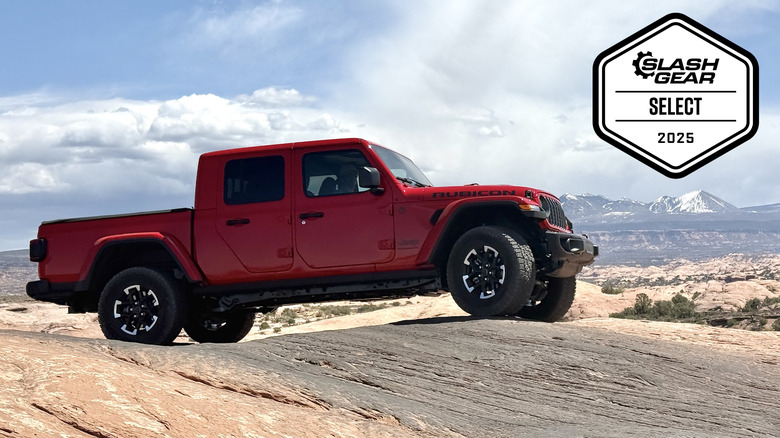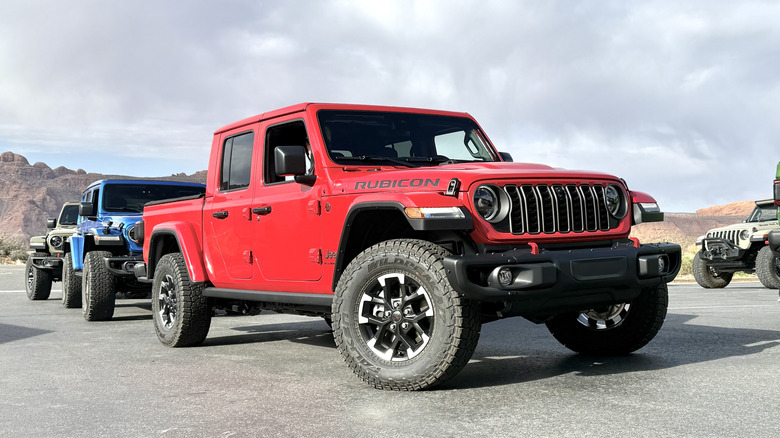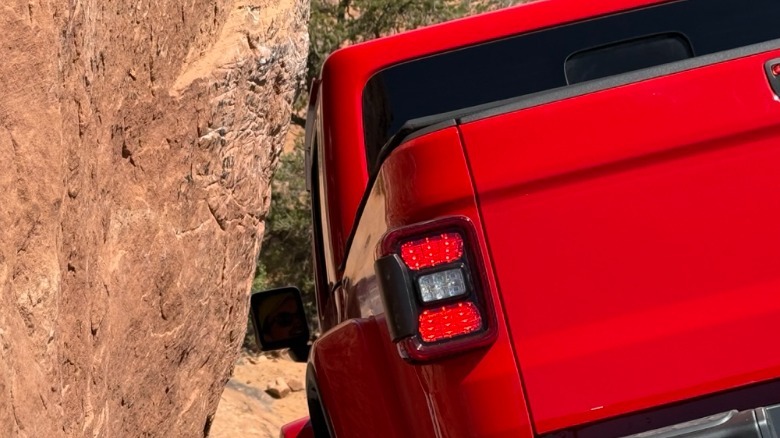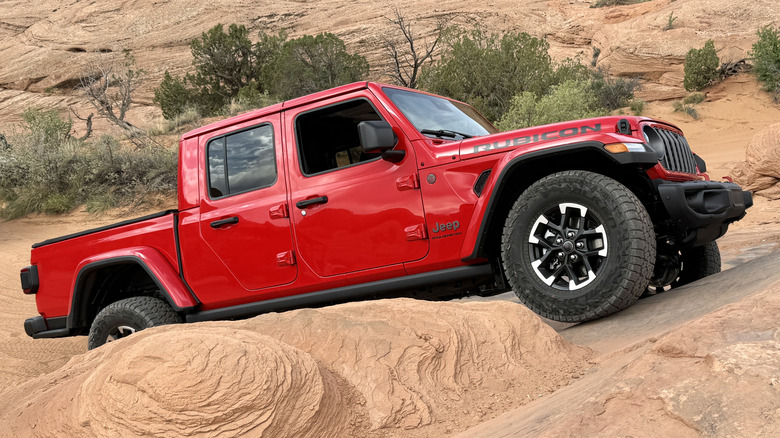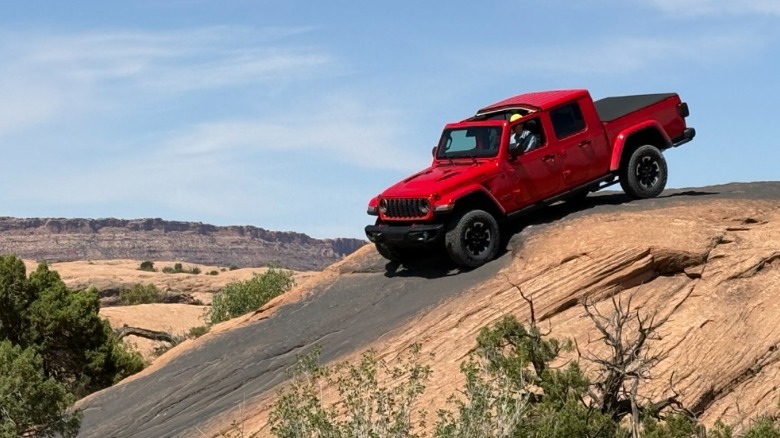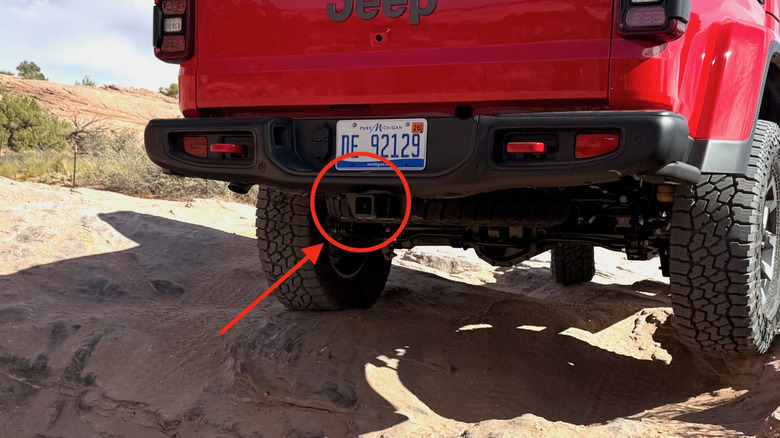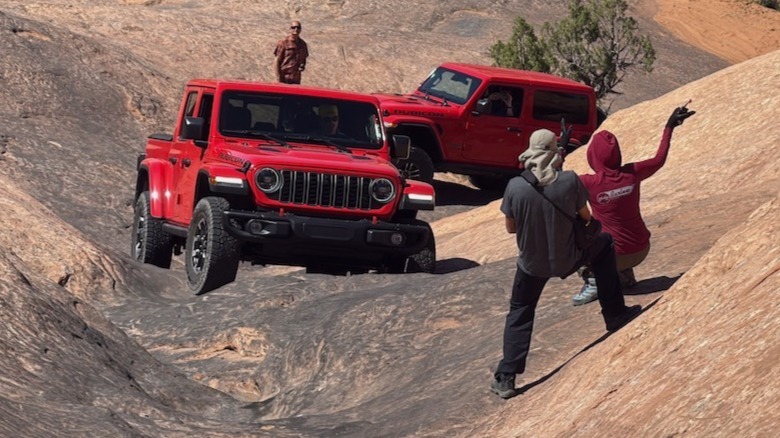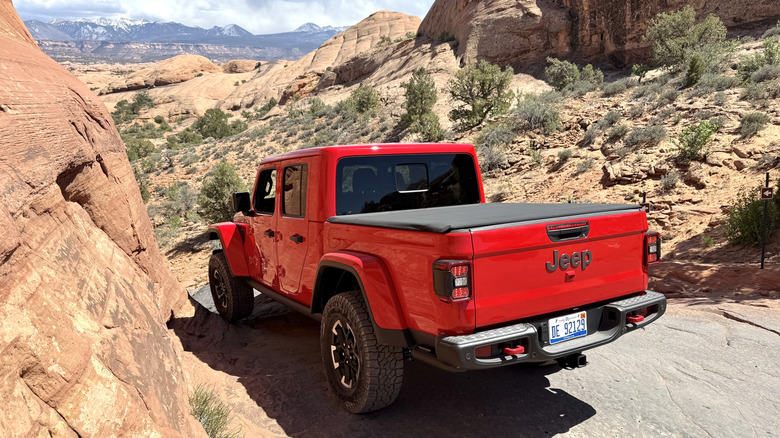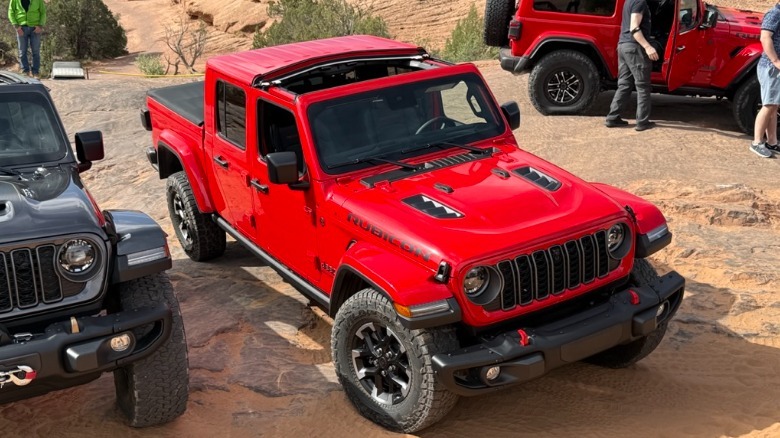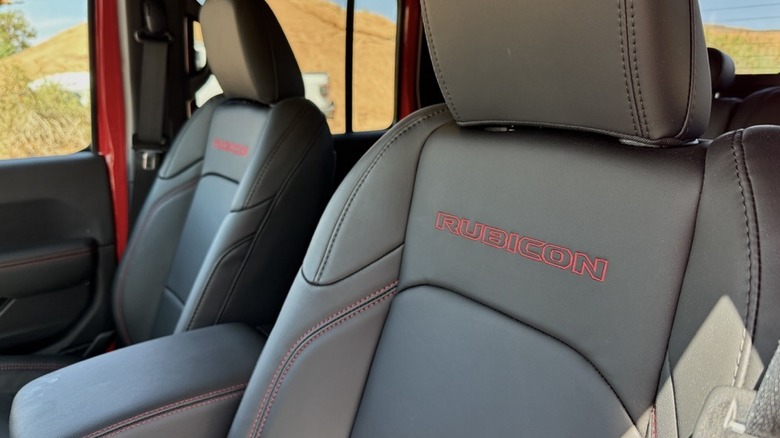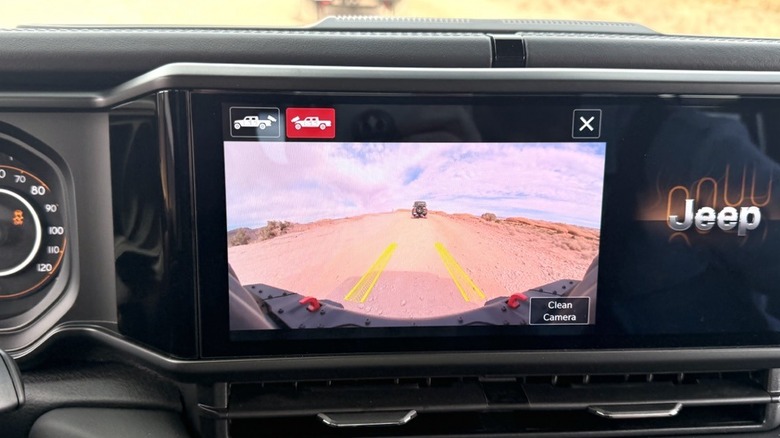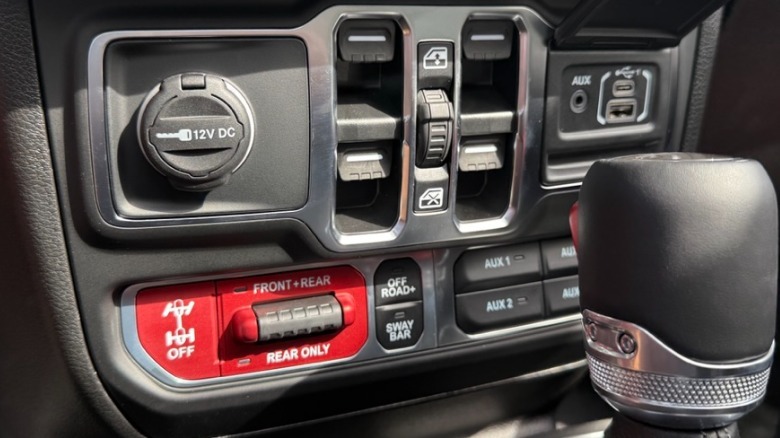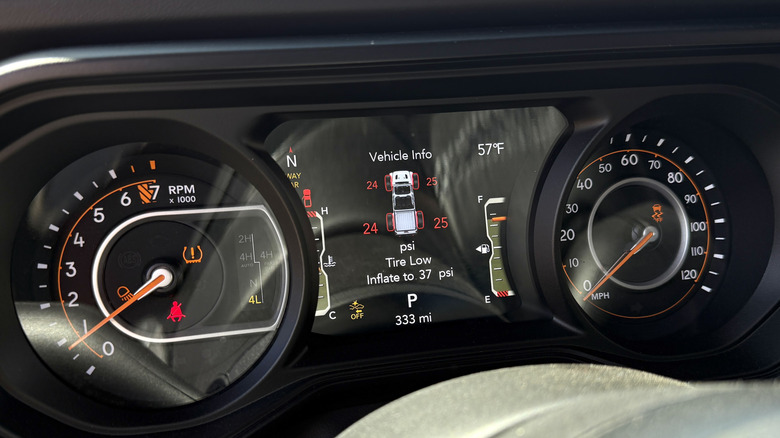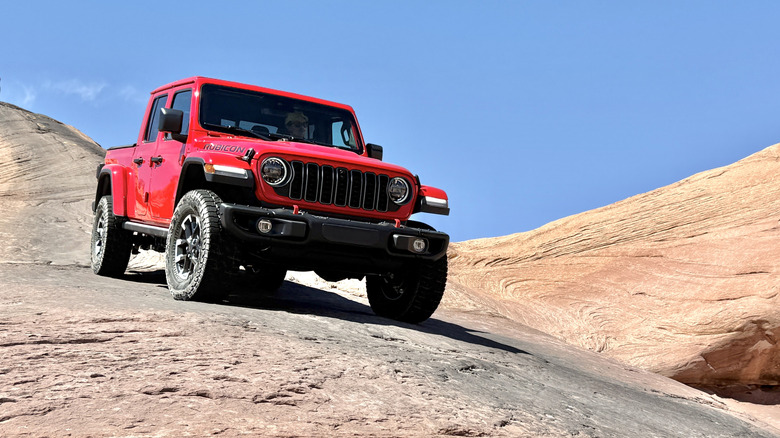2025 Jeep Gladiator Rubicon Review: Is The Off-Road Rep Still Warranted?
- One of the best off-roaders on earth
- Rugged and heritage-honoring looks
- Impressive towing capacity
- Upscale screen tech for a pickup
- Loud and poorly insulated cabin
- Cramped interior considering big exterior dimensions
- Limited powertrain selection
Moab, Utah is one of the most beautiful places I've been to inside the United States. It is home to some of the starkest and loneliest landscapes you'll find in the American west. The small town, populated by around 5,200 inhabitants, is a stone's throw from Arches National Park and just a few hours away from places like Zion and Bryce National Park. There are gargantuan mountainsides of stacked sandstone, stretches of unforgiving terrain as far as the eye can see, and to cap it all off, there are tiny alien-themed roadside stands selling beef jerky.
For off-road enthusiasts, however, Moab is also a bit of a motoring Mecca. It has some of the toughest trails available to four-wheeled vehicles, and every year, Jeep owners descend on this spot in the Utah desert (by Jeep's estimates about 20,000 people), destined for spots with some of the craziest names you've ever heard.
Chicken Corner's Safari, Dead Horse Point, and Poison Spider are just a few of the trails you can travel during April's Easter Jeep Safari (or other less-crowded times of the year). This year, Jeep hosted an event showcasing their concepts and then took a group out on the trails in Wranglers and Gladiators. Our task? Make it through a trail called Hell's Revenge (not intimidating at all, right?). I was given the keys to a 2025 Gladiator Rubicon, a driving partner who would share the off-roading responsibilities, and a two-way radio. Giddy up.
Not a Wrangler, but Wrangler adjacent
To the layman, the Gladiator is simply a pickup-truck version of the Jeep Wrangler SUV. And it's not exactly an image the Jeep reps shy away from: after all, the Wrangler is possibly the world's most iconic off-roader. Sure, Land Cruisers and Broncos have lots of dirt-dominating credibility, but the Wrangler is known almost exclusively for its ability to crawl over rocks, ford through rivers, and generally master any dirty landscape it sees.
With the Gladiator, it's mostly the same story: lots of off-road capability, lots of the same components, and a very similar look. Some key differences in dimensions, though, make the truck a bit different, and made me a bit less confident before a day of off-roading.
The Gladiator has a much longer wheelbase (137.3 inches compared to the four-door Wrangler at 118.4 inches), which changes the breakover angle, and a big overhang in the rear that changes the departure angle. The overhang is different, too. The four-door Wrangler's rear overhang is about 40 inches, while the Gladiator's is 51 inches. That's 11 inches of extra underbody to get caught up on rocks, scrape along gulleys, and possibly get me stuck in the desert. The added wheelbase leads to a slightly better ride on the highway and a more stable feel on the open road, but we only spent a few miles on paved roads before airing down and hitting the trails. Not enough time to enjoy those benefits much.
Checking all the angles
When it comes to approach and departure angles, the higher the number, the better. With the Gladiator Rubicon, the angles are as follows. Approach: 43.4. Breakover: 20.3. Departure: 26.0. Ground Clearance: 11.1 inches. Impressive numbers by any off-road standard, but the Wrangler Rubicon does a bit better. With its biggest set of available wheels and tires, the Wrangler can easily beat those numbers. Approach: 47.4. Breakover: 26.7 (4-door). Departure 40.4. Ground Clearance: 12.9 inches.
Those are some pretty hefty differences, there, and in extreme off-road situations — like the trails that streak their way through the Utah desert — the little details like approach and departure angle matter. They're the difference between scraping, or making it down a big hill without incident.
There were a few real-world manifestations of the differences between these two Jeeps. The first was the Gladiator's increased stability on steep inclines and declines. Where Wranglers would occasionally lift a tire under heavy articulation, the Gladiator stayed four-tires down. The second, less-fun difference was the scraping and slamming heard from underneath the Gladiator throughout the day. When Wrangler Rubicon models would take an approach straight on, the guides would tell Gladiator drivers to go at an angle. When the Wranglers would avoid a scrape, the Gladiators would typically drag the rear section a bit. The tow hitch received most of the damage, but skid plates and rock rails all took their fair share of damage too. Thankfully, the Gladiator could easily take the abuse.
Assessing the damage
Touch-down moments where bits of the Gladiator's undercarriage made contact with the ground, big-drop-off moments that sounded like they'd rattled the surface of the earth, were actually just little surface-level scrapes to the Gladiator. Metal grinding along petrified sand dunes is a terrible sound; worse than nails on a chalkboard, if you ask me.
Despite the unpleasant screeching, though, the Gladiator took it all in stride. Climbing underneath the Gladiator about a half-dozen times to assess damage, I was surprised to find little more than scrapes. The tow hitch is the lowest part underneath the rear and, after multiple scrapes and bangs, it looked totally intact and nearly unharmed.
Throughout the day, my driving partner and I switched off a few times, giving each other the opportunity to pilot the Gladiator for the thrilling (and terrifying) tasks that lay before us. During the times I wasn't driving, I would often jump out to help guide my driving partner, pointing various directions to avoid damage on the trail. With unknown quantities like cliffs and sheer rock faces, I was shocked to see just how stable and secure the Jeeps looked from the outside. What felt dramatic and terrifying from the inside looked like easy-going on the outside. That's not uncommon in off-roading — it looks way easier from the outside than it feels from behind the steering wheel — but hopping out for a new perspective gave me a big boost in confidence in both my abilities, and in the Gladiator's.
Power and prowess come standard
All this capability and confidence is par for the course for the Gladiator: not much has changed this year. Small changes however, do include the addition of power locks and power windows as standard, as well as an available pre-conditioning setting to cool down (or heat up) the interior via Jeep's mobile app, but all the hardware remains the same.
Under the hood of the 2025 Gladiator there's a stalwart powertrain that every self-respecting Jeep fan is familiar with: the Pentastar V6. The 3.6-liter, six-cylinder engine makes 285 horsepower and 260 lb-ft of torque and, for 2025, it's available exclusively with an 8-speed automatic transmission. Jeep previously offered a manual, but that's been removed this year. Honestly, I'm happy to have an automatic out on these trails. At crawling speeds, managing a clutch pedal is not high up on my priority list.
Out in the desert, the Pentastar makes a ton of sense. The throttle sensitivity is perfectly dialed in for slow-speed off-roading; it has more than enough power and torque to get you up, over, and around obstacles. On the highway, though, it's pretty unrefined. The engine, along with pretty much every other part of the Jeep experience, is a bit noisy. Thankfully it pays dividends: the Gladiator can pull a maximum of 7,700 pounds, beating out trucks like the Ford Ranger and tied for the lead in the midsize class with the Chevrolet Colorado and GMC Canyon.
While not a priority, comfort is pretty good
If you've been in any Wrangler or Gladiator product in the last decade, you'll likely recognize just about every switch and bit of upholstery: there haven't been many updates in that department. Thankfully, the Jeep designers have kinda nailed the aesthetic over the years. The interior doesn't feel fancy, upscale, or plush, but it does lean towards the refined side of things when you consider its overall capabilities. It's just nice enough to make it a serviceable daily driver, without abandoning a look and feel that's true to its purpose.
Interior storage is, to put it nicely, limited. Despite the generous exterior dimensions, the Gladiator's interior is relatively cramped. You're not quite shoulder-to-shoulder with passengers, but you're close to each other. Door storage is provided via some small nets (that, of course, disappear if you remove the doors), and center-console storage is thin too. The lack of a dead pedal where you can rest your left foot while driving is also a demerit for the interior, but like all Jeep comfort drawbacks, it shouldn't be concerning enough to be a dealbreaker for off-road purists.
Tech and easy engagement of off-road hardware
A large, landscape-orientation 12.3-inch touchscreen is standard on the Gladiator and it comes with features like wireless smartphone connectivity, and top trims even get an integrated off-road camera. The Gladiator Rubicon I was driving? You better bet it had that camera. The touchscreen itself is crisp, clear, and excellent on the eyes. The forward facing camera was a big confidence booster in nose-down off-road scenarios, especially when you feel like you're tipping downward at a near-90-degree angle. It helps the driver navigate rocky terrain, avoid big obstacles, and gently approach staircase-style step-ups.
A small quibble is that the camera doesn't utilize all the available real estate. There's a small black bar above the camera display and a Jeep logo to the right — I'd love to have this big display spread across the entire screen and improve the visibility even further.
Disconnecting the sway bars, engaging the lockers (front and rear or rear only), shifting from 4Hi to 4Lo, and generally commanding the Gladiator's off-road hardware was relentlessly easy. Jeep has the control center on this stuff nailed. The buttons are all clearly labeled, within reach, and have a tactile engagement. The steering wheel is the same way. Clearly labeled, easily located, and outfitted with simple controls. It had been a while since I drove a Gladiator, but it all felt like second nature after a short time behind the wheel.
A surprise from the tires
An interesting piece of tech I didn't expect to be impressed by was the Gladiator's tire-pressure monitoring system. Airing down in the parking lot was required before we set out for the day, prepping for the insane terrain we were about to tackle. To do so, we used various combinations of keys and tire pressure valve tools. What we didn't have were the fancy pressure valve tools that stopped at a certain predetermined pressure, so we had to rely on the Jeep's on-screen pressure monitor.
The on-screen monitor was surprisingly accurate and kept up at a lightning pace. Most of these systems have a delay and can't give you a proper read-out for several minutes, but the Gladiator's was on point. Dropping the PSI down into the low 20's was simple with a passenger shouting out the pressures as I went and I didn't need to let out any additional pressure throughout the day. Without testing all the midsize trucks in the class back-to-back, this is a hard attribute to compare, but it still took some of the stress out of the morning activities.
2025 Jeep Gladiator Rubicon Verdict
At the end of the day, our group pulled off the trail and let out a collective sigh: we had made it back to terra firma. Not counting a few scrapes and scratches on the undercarriage, the Gladiator made it through some pretty hair-raising terrain without missing a step. So, how did it stack up against the other midsize rivals? Well, the price range for Jeep Gladiators is pretty typical for the class.
Base Gladiator models start at $39,995 (including $1,895 destination fee) but the Rubicon model that I was driving around has a starting MSRP of $52,995. That's a big jump, but it is typical for the class up against off-road specialists like the Chevrolet Colorado ZR2 Bison or the Toyota Tacoma Trailhunter and TRD Pro twins I tested earlier this year. Both the Colorado and the Tacoma feel more refined on road, and when you're sitting inside them at a stand-still, but the Jeep is impossible to deny when it comes to outright capability and rugged styling. Ultimately, the choice between the three would come down to what my daily commute looked like, and whether it included treacherous terrain like the Utah desert.
